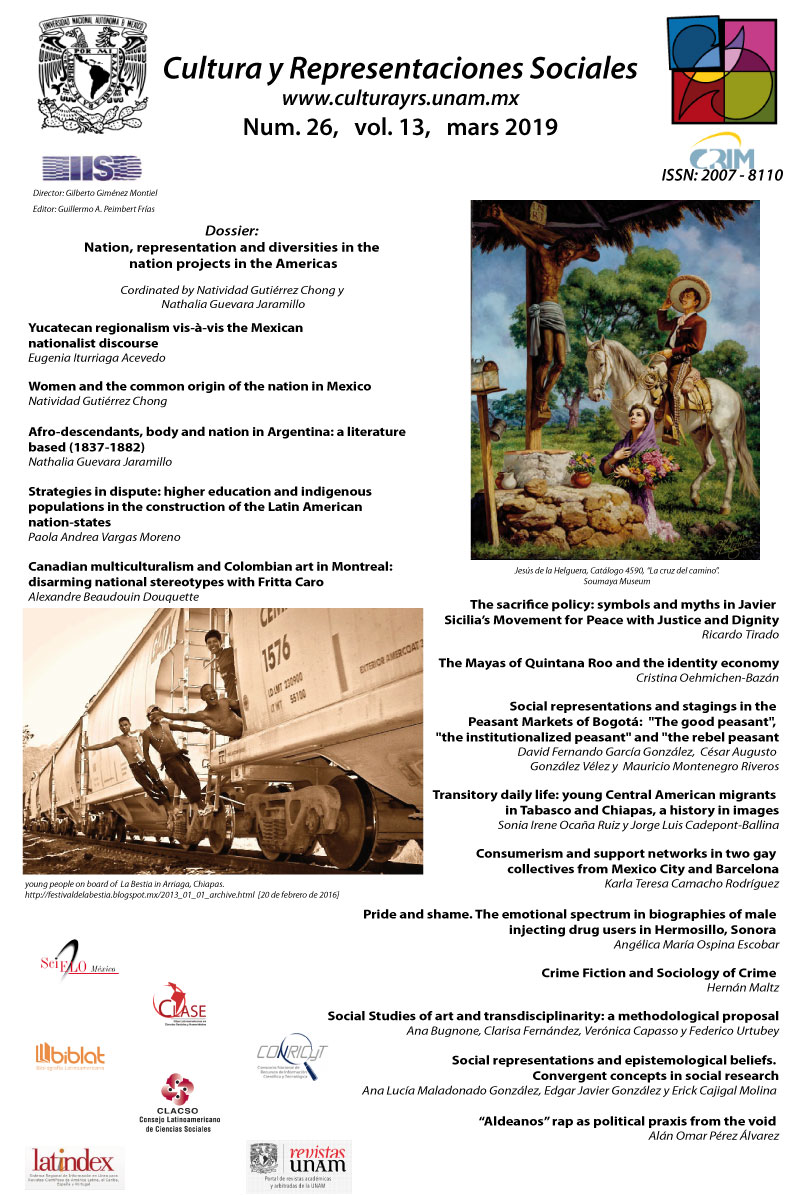Abstract
This article is the result of an investigation developed throughout 2017 by three members of the Advertising, Society and Consumption group of the Central University of Bogotá. The objective of the research was to track and analyze the representations that circulate in the Peasant Markets (hereinafter MC) organized by the Mayor’s Office and other institutions of the Bogota district government since 2004. This interest has to do with our conviction, at the same time epistemological and political, that social representations are, as the sociologist Pierre Bourdieu (1995) would say, structuring and structured constructions. In other words, representations are structures of thought internalized by the subjects and, at the same time, historical constructions of a collective nature that help to co-produce the social world. Starting from this premise, we consider that it is pertinent to deconstruct the representations on the field and the peasants that are (re) produced and negotiated in institutional spaces such as the MC. The main objective of this text is, then, to analyze the aesthetic and discursive elements of the various advertising pieces that circulate about CMs, and to determine the nature of the representations that are put into play there. The first section characterizes the corpus of advertising and institutional pieces with which it was worked (which included images, flyers, photographs, videos and press releases), and describes the interpretation process based on the main categories and variables of analysis. Following are some considerations of a conceptual nature with regard to social representations and what we have called “staging”. Finally, in the third part, various aesthetic and discursive elements of the advertising pieces associated with MCs are characterized, and a critical synthesis of the most recurrent representations on the field and the peasants who circulate there is offered.
References
Abric, J. (1994). Prácticas sociales y representaciones sociales. Ediciones Coyoacán, México
Archila, M. (2005). “Imágenes de los subalternos en Colombia 1886-1958”. Revista Logos, (8), 71–88.
Agustín, M. (2010). “El contenido de las imágenes y su análisis en entornos documentales”. En: Polisemias visuales. Aproximaciones a la alfabetización visual en la sociedad intercultural. Ediciones Universidad de Salamanca; pp: 85-116.
Banks, M. (2001). Visual methods in social research. UK, Sage.
Bartmanski, D.; Alexander, J. (2012). “Introduction. Materiality and Meaning in Social Life: Toward an Iconic Turn in Cultural Sociology”. In Jeffrey Alexander, Dominik Bartmanski (Ed.), Iconic Power. Materiality and Meaning in Social Life. New York: Palgrave Macmillan; pp. pp. 1–14.
Berger, J. (1972). Ways of Seeing. London, Bristish Broadcasting Corporation.
Berger, P. y Luckmann, T. 1967 (2006). La construcción social de la realidad. Buenos Aires, Amorrortu editores.
Bichon, B. (2014). “Colombia. Experiencia de Mercados Campesinos de Bogotá”, en Lacroix, Pierril; Cheng, Gianmarco (Eds). Ferias y mercados de productores: Hacia nuevas relaciones campo-ciudad. Centro Peruano de Estudios Sociales. Lima - Perú.
Boehm, G. (2012). Representation, Presentation, Presence: Tracing the Homo Pictor. En Alexander, J.; Bartmanski, D. (Ed.), Iconic Power. Materiality and Meaning in Social Life. USA: Palgrave Macmillan; pp. 15–23
Bourdieu, P. W. L. (1995). Respuestas. Por una antropologia reflexiva. México, Grijalbo.
Bushnell, D. (1994). Colombia. Una nación a pesar de sí misma. Bogotá, Planeta.
Colmenares, G. (1968 [2008]). Las convenciones contra la cultura. Ensayos sobre historiografía hispanoamericana del siglo XIX. Medellín, La Carreta Editores.
Cruz-Rodríguez, E. (2013). “Todos somos hijos del café”: Sociología política del Paro Nacional Cafetero. Entramado, 2(9); pp. 138–158.
Debray, R. (1995). El Estado Seductor. Las revoluciones mediológicas del poder. Buenos Aires, Manantial.
DANE, 2011 (Departamento Administrativo Nacional de Estadística. Encuesta General de Hogares). Encuesta general de hogares. Bogotá. Disponible en: https://www.dane.gov.co/files/investigaciones/condiciones_vida/calidad_vida/Presentacion_ECV_2011.pdf
Departamento Nacional de Planeación. (2015). Diagnóstico de la pobreza rural. Colombia 2010-2014. Bogotá. Disponible en: https://colaboracion.dnp.gov.co/CDT/Agriculturapecuarioforestal%20y%20pesca/Pobreza%20Rural.pdf
Floch, J. M. (1993). Semiótica, marketing y comunicación. Bajo los signos, las estrategias. España, Paidós.
García González, D. (2017). “The Case of Chocquibtown: Approaches to the Nation in Contemporary New Colombian Music”. En Territories of Conflict. Traversing Colombia Through Cultural Studies. University of Rochester Press; pp. 221–230.
Geertz, C. (1996). La interpretación de las culturas. Gedisa: Barcelona.
Goffman, E. (1993). La presentación de la persona en la vida cotidiana. Buenos Aires, Amorrortu Editores.
González, J. A. (1987). “El buen salvaje de Rousseau. Inflexión de la antropología y de la estética”. En Gazeta de Antropología, 5. Disponible en: http://hdl.handle.net/1048/13768
González, J. E. (2006). “No doy por todos ellos el aire de mi lugar”. La construcción de una identidad colombiana a través del bambuco en el siglo XIX. Universidad Autónoma de Barcelona.
Gutiérrez, J. (1961). De la pseudo-aristocracia a la autenticidad. Psicología social colombiana. Bogotá, Tercer Mundo.
Kalmanovitz, S. (21 de mayo de 2017). “La cuestión agraria, de nuevo”. En diario El Espectador. Bogotá.
Lefebvre, H. (1980). La presencia y la ausencia. Contribución a la teoría de las representaciones. México, Fondo de Cultura Económica.
Lobo, G. (2009). Colombia: algo diferente de una nación. Bogotá: Universidad de Los Andes.
Ordoñez, F., et al. (2011). Economía campesina, soberanía y seguridad alimentarias. La experiencia de Mercados Campesinos en Bogotá y la región central de Colombia. Bogotá, Secretaria Distrital de Desarrollo Económico, Comité de Interlocución Campesino y Comunal.
Pink, S. (2011). “Digital visual anthropology. Potentials and challenges”. En: Banks, Marcus y Jay Ruby (Eds.) Made to be seen. Perspectives on the history of visual anthropology. The University of Chicago Press; pp: 209-234
Rojas, C. (2001). Civilización y Violencia: La búsqueda de la identidad en la Colombia del siglo XIX. Bogotá, Norma.
Romagnoli, F. (2015). Small-holders market participation in Colombia: An Assessment of Mercados Campesinos Project in Boyacá. Scuola di Economia e Management. Universitá Degli Studi Firenze.
Sanín, J. D. (2010). “Made in Colombia. la construcción de la colombianidad a través del mercado”. En Revista Colombiana de Antropología, 46; pp. 27–61.
Serje, M. (2011). El revés de la nación. Territorios salvajes, fronteras y tierras de nadie. Bogotá, Universidad de Los Andes.
Serrano, J.; Viveros, M. (2006). “Regímenes de ordenamiento social y representaciones de diferencia en Colombia contemporánea”. En Sexualidad, estigma y derechos humanos: desafíos para el acceso a la salud en América Latina. Lima, CLAM-Ciudadanía Sexual; pp. 93–112.
Silva, R. (2006). Sociedades campesinas, transición social y cambio cultural en Colombia. La encuesta folclórica nacional de 1942: aproximaciones empíricas y analíticas. Medellín, La Carreta Social.
Solórzano, A. (2012). Semiótica: diseño gráfico y cultura. Medellín, Universidad Pontificia Bolivariana.
Uribe, M. T. (2001). Nación, Ciudadano y Soberano. Medellín, Corporación Región.
Licencia Creative Commons Revista Cultura y Representaciones Sociales / Universidad Nacional Autónoma de México se distribuye bajo una Licencia Creative Commons Atribución 4.0 Internacional (CC-BY 4.0)



